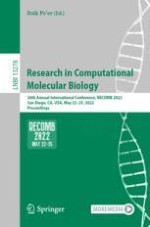2022 | Buch
Research in Computational Molecular Biology
26th Annual International Conference, RECOMB 2022, San Diego, CA, USA, May 22–25, 2022, Proceedings
herausgegeben von: Itsik Pe'er
Verlag: Springer International Publishing
Buchreihe : Lecture Notes in Computer Science
